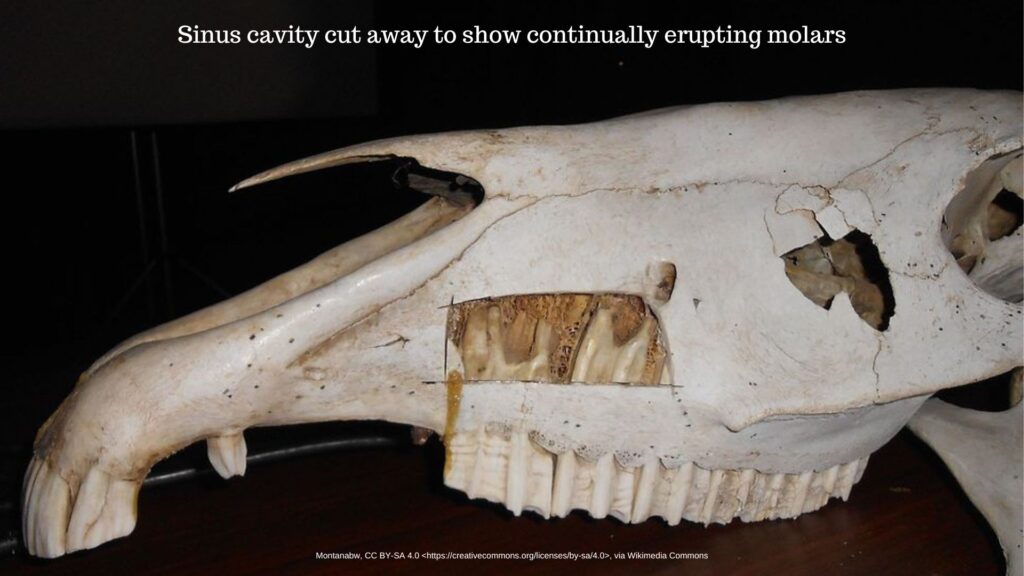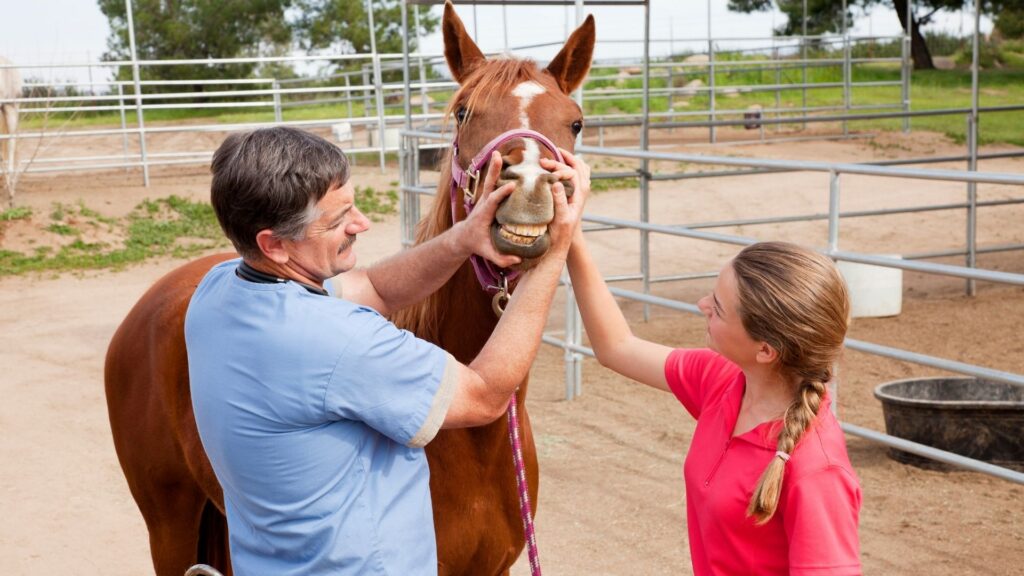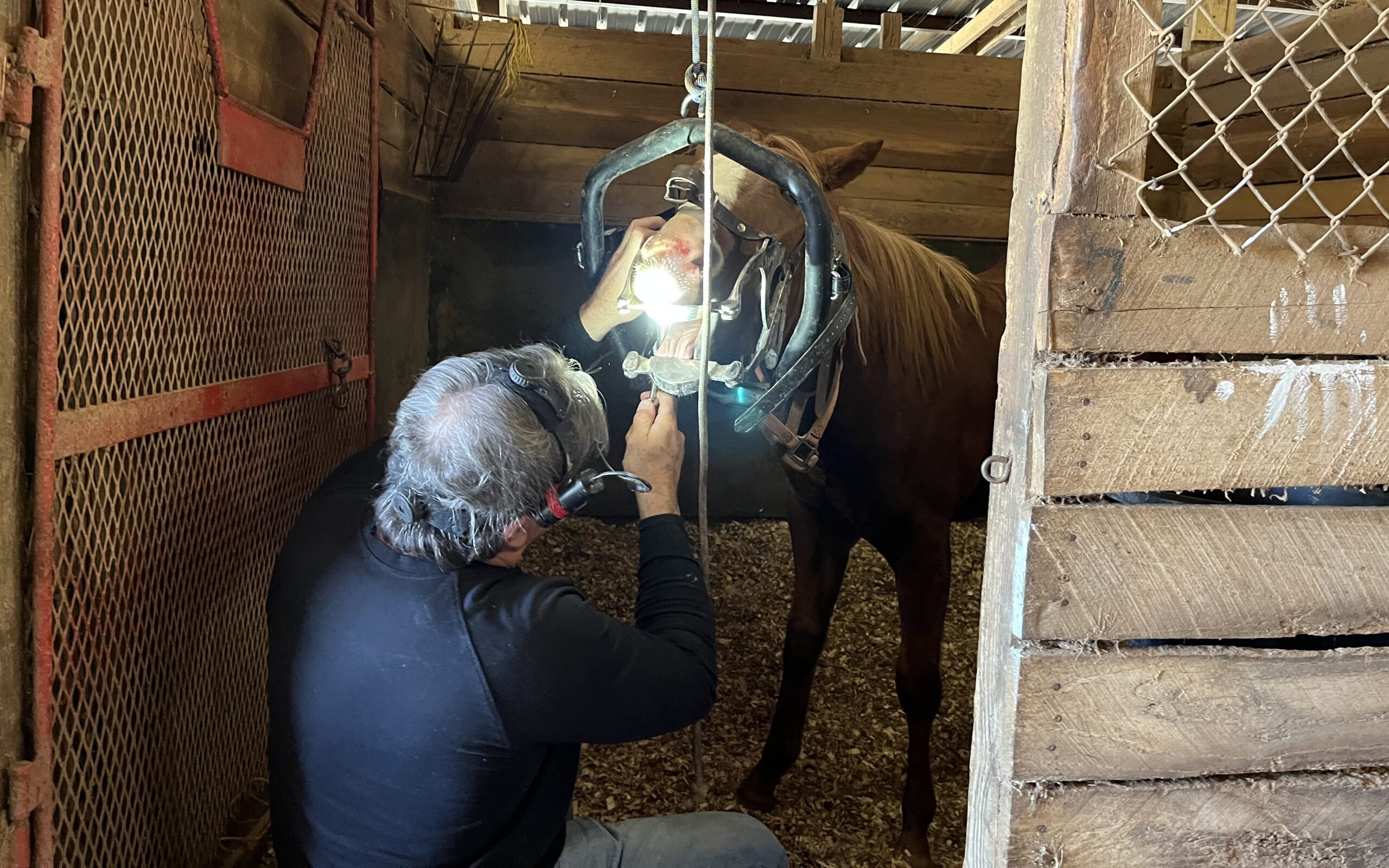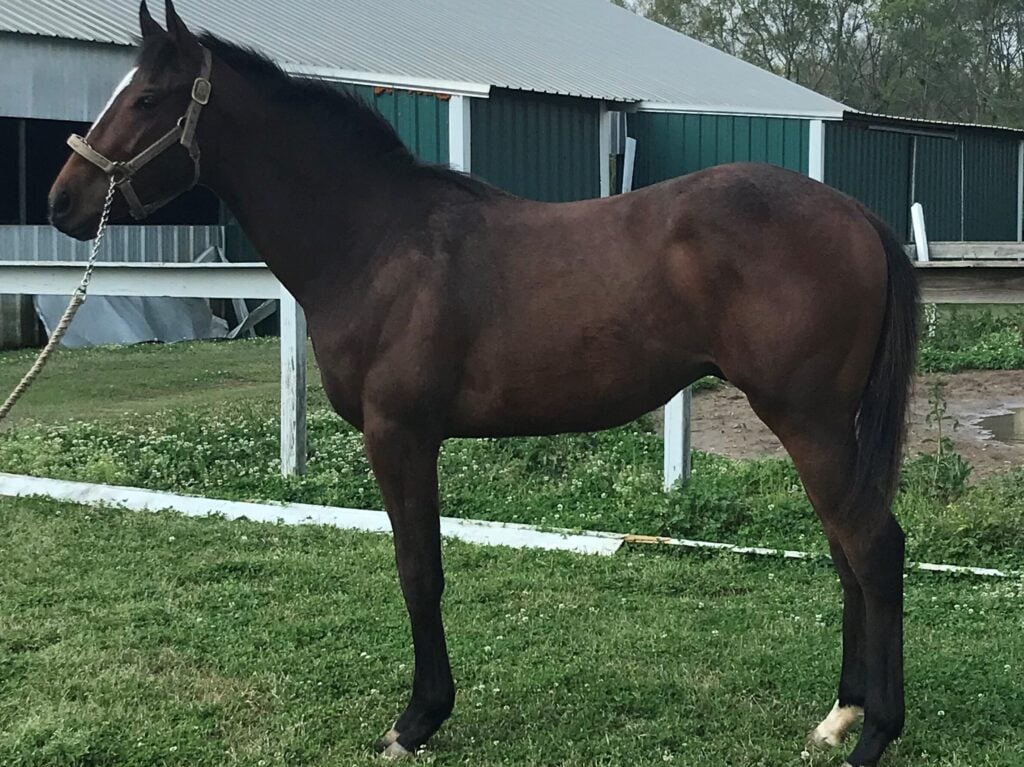Last updated: March 2, 2023
Any links on this page that lead to products on Amazon are affiliate links and I earn a commission if you make a purchase. Thanks in advance – I really appreciate it!
You may have heard the saying, “Never look a gift horse in the mouth.” But when you’re trying to guess an animal’s age or assess oral health issues, it is precisely what you should do!
We recently had an equine dentist come check our horse’s teeth, and I took the opportunity to ask a lot of questions.
Horses have a lot of teeth, usually 40. They also have two sets of teeth; when they’re young, they have temporary baby teeth. When they get older, the baby teeth are replaced by their permanent adult teeth, which include incisors, canines, molars, and premolars.
I wrote this article in conjunction with a few other articles on equine dental. For you to get the most out of it, use the links I provide. The links will bring you to articles about specific equine dental topics that are informative and helpful for horse owners.
One such post is A Horse’s Teeth: What Can We Learn, Age Health More? In it, I discuss health issues related specifically to horses’ teeth which can easily be overlooked by many people who might not have personal experience or knowledge about these issues.
But first: some fun facts!

Fun facts about horse teeth
- Equine dentistry or horse dentistry has a long history. It first started in the 15th Century but only developed into the scientific discipline of today in the latter half of the 19th Century.
- For centuries, people have aged horses by their teeth. This isn’t a reliable method of determining a horse’s age.
- Horses’ teeth take up more space in their head than their brains!
- Also, horses’ teeth continuously erupt throughout their youth and middle age to allow for the high levels of degradation caused by an abrasive diet of grass and hay. They only stop erupting once the horse is really old.
- Horses have unique dental structures called dental arcades (4 rows of cheek teeth and four rows of incisors).
- Equine teeth are hypsodont, meaning ‘high-crowned teeth’ with enamel extending past the gum line.
- Male horses have more teeth than mares.
How many teeth do horses have?
An adult horse can have anywhere between 36 and 44 permanent teeth, while mares typically have between 36 and 40 teeth. Thus, a horse definitely has more teeth than an adult human.
Here is the approximate timeline of the eruption of the different types of teeth in horses:

What are the different kinds of horse teeth, and at what age do they come in?
Foals/at birth
A foal is born without incisors, but its central deciduous incisors erupt at 6 to 8 days. The second pair of deciduous incisors start at 6 to 8 weeks, and the third pair at 6 to 8 months.
By the time a foal reaches eight months, it should have all its baby teeth. In all, a foal has around 24 deciduous teeth (also called milk or baby teeth). Permanent teeth start coming in when a horse is about 2.5 years old; by five years old, it should have all of its permanent teeth.
For more information about the teeth of young horses, check out this article: Are Baby Horses Born With Teeth? Foal and Yearling Dental.
At 2 ½ years
At this age, the central deciduous incisors fall off and are replaced by permanent adult incisors. Don’t be too shocked to see these entirely worn down by the time your horse is four years old.
Incisors are the teeth a horse uses to clip grass. There are six incisors on the top jaw and six more on the lower jaw, making a total of 12.
At 4 ½ years
At this age, the last pair of deciduous incisors are replaced by permanent incisors. These, too, will be in wholly by the time the horse is about five years old.
Canine teeth are also present in horses aged four years and over. In mares, smaller/rudimentary canine teeth accumulate a lot of tartar and often become loose. Such teeth need to be removed.
Canines are most prone to tartar accumulation. That is why dentists recommend grinding them to 2mm to 3mm, followed by a round of polishing.
Horses also have 12 premolars and 12 molars – also known as cheek teeth or jaw teeth.
5 years and over
At about the age of 5, cups appear on the teeth. (The age at which cups appear can vary from horse to horse and should not be used to guess a horse’s age).
Cups are enamel rings on the tooth’s surface towards the edge of the incisor close to the tongue. In 5-year-old horses, these are characterized by deep open pockets often packed with food debris. Further degradation paves the way to an enamel ring with dark-colored dentine- called the mark.
If you wonder how many teeth your horse has, you certainly don’t need to look inside their mouth. In this guide, I cover everything you need to know about horse teeth, the different types, and the ages at which they develop. We will also discuss wolf teeth and the teeth floating procedure – which is very important for all horses.
Between 6 and 8 years
Between 6 and 8 years, a horse develops cups on the second pair of its incisors just as the cups on the central incisors disappear.
Cups on the outer incisors could disappear anywhere between 9 and 15 years. Some horses have retained teeth, and you might need an equine dentist’s remove these.
12 years and above
The mark from central incisors disappears at about 12 years of age – although, in draft horses, this can occur at around 15 years, and in Arabian horses – about 20 years.
15 years and above
Many horses aged 15 and over start losing their dental enamel, which causes changes in the shape of the teeth and could even be painful due to sharp edges. Also, the incisors and other teeth become rather loose, which could even warrant an extraction to prevent pain.
Your horse is aging, and it’s essential to pay close attention to its teeth. Many horses start losing their tooth enamel when they turn age fifteen; these changes have been known to result in a range of problems, such as uneven teeth. It can also form sharp edges; if this happens, the teeth may need to be pulled before they cause too much pain.

What are wolf teeth in horses, and when do they develop?
Wolf teeth are small vestigial premolar teeth not found in all horses; about 70 percent of horses have them. They are comparable to wisdom teeth in humans.
If a horse gets wolf teeth, they usually come in between 6 to 18 months of age. An equine dentist might recommend an extraction if a horse develops extremely large or aberrantly placed wolf teeth.
Extraction is also necessary for horses that are worked with a bit in the mouth. Some wolf teeth exfoliate naturally at the same time when the first cheek tooth cap falls off (around three years of age). In some horses, wolf teeth tend to cause extreme pain and lead to bad biting habits.
An equine dentist sedates the animals to remove wolf teeth and uses a contraption that holds their mouths open. They next use a long-handled extracting tool to remove the tooth. You can see the procedure in the above picture of an eighteen-month-old colt having its wolf teeth removed.
Here is a YouTube video I made about horse teeth.
Do horse teeth grow continuously?
A horse’s teeth continue to grow throughout its life and will also wear out at the same rate as its growth rate. The wearing is also not uniform and could lead to sharp or uneven edges, which could be painful for your horse while chewing.
That is why a vet needs to examine a horse’s teeth bi-annually and also use a procedure called ‘floating’ to make the teeth smoother. (I will explain teeth floating in the next section.) Once a horse is really old, the teeth stop coming out, leading to gaps in-between teeth.

Floating horses’ teeth.
Floating teeth is an equine dental procedure that involves filing down the sharp teeth that may be bothering the horse, especially while eating or holding the bit in the mouth.
All racehorses need to have this procedure done when they start their racing careers. Dentists recommend teeth floating for all horses once a year or once every two years.
Signs your horse needs to have its teeth floated include:
- Throwing back its head
- Unusual head tilting/movements
- Dropping grain
- Showing signs of pain/discomfort
The first floating procedure helps fit the racing bit firmly inside the horse’s mouth. Many horses perform much better after having their teeth floated.
Why it’s called floating,
The reason behind the procedure’s peculiar name is that dentists use a file or a rasp called a float to gently file away sharp hooks and edges.
Should you ride your horse after floating its teeth?
Since teeth floating is done under anesthesia, it is best to wait several hours or a day for the horse to return to normal before riding. Some horses tend to get violent after anesthesia, so it is best not to stress it.
To learn more about floating horses’ teeth, read my article: How Often Does My Horse Need Its Teeth Floated and Why?

Conclusion
An adult male horse has around 40 to 44 permanent teeth, while mares have between 36 and 40 teeth. Naturally, a horse has way more teeth than humans.
Horses’ teeth grow continuously throughout their lives and wear down at the same rate because of the texture of the food they eat. That is why they need regular dental exams and procedures like floating and wolf teeth extractions to keep them pain-free and prevent further dental complications.
I hope this guide helps you take better care of your horse’s teeth.
FAQs on Horse Teeth
Can a horse survive with no teeth?
A domestic horse without teeth can survive with attention and care from its owner. But a wild horse with no teeth is going to starve. Once the horse’s teeth are worn out, eating grass becomes impossible because they have no chewing ability left in their mouth.
What you should feed a horse with no teeth?
If your horse has no teeth continue to allow it access to pasture grass and hay. However, you will likely need to supplement their diet with senior feed, soaked forages, and grains to ensure they have sufficient fiber, vitamins, and minerals. Consult your vet for more information.
References:
- Equine Dental Floating (Crown Osontoplasty).
- Equine dental and periodontal anatomy: A tutorial review

About the Author: Miles Henry
Lifelong Horseman | Racehorse Owner | Published Author
Miles Henry brings over 25 years of hands-on experience training and owning Thoroughbred racehorses. Raised with Quarter Horses and Appaloosas, he’s spent a lifetime learning from horses—on the track, in the barn, and in the field. Today, he runs a small but successful racing stable in Louisiana and shares real-world insights on HorseRacingSense.com, helping horse owners, fans, and bettors navigate the sport with confidence.
📚 Books: View Miles’s books on Amazon »
🎧 Podcast Guest: Animal Tales Ep. 32 |
YouTube Interview
📩 Newsletter: Sign up for racing tips and horse care advice »
🔗 Follow Miles:
Twitter |
Facebook |
YouTube


